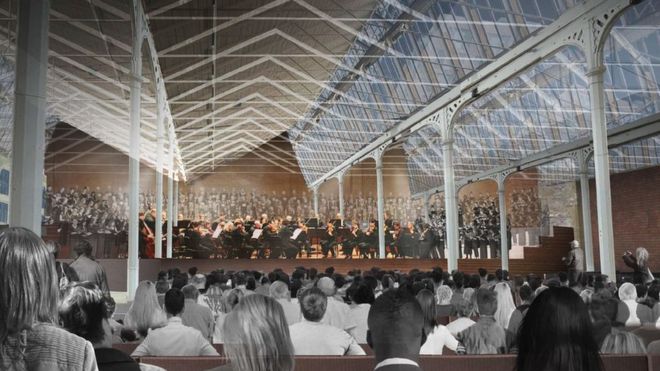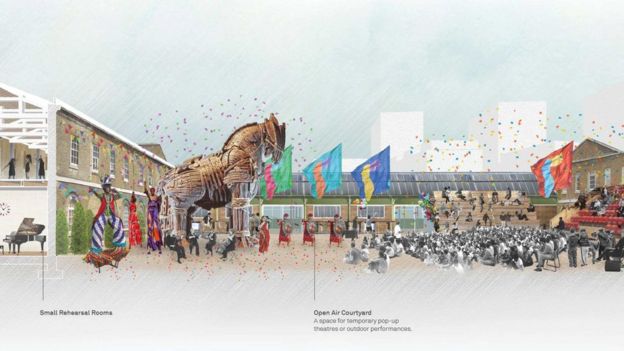How the first home of Arsenal FC developed across the centuries – and what is happening to it now.
In 1513 Henry VIII set up a dockyard at Woolwich to build the royal ship which came to be known as the ‘Great Harry’. Later, in 1559 Elizabeth I came to Woolwich to launch the ship Elizabeth Jonas.
In 1695 the Royal Laboratory was established and from 1716 onward the Royal Regiment of Artillery and the first barracks were established as well as a brass foundry, and of course the Dial Square buildings of which we have written many times before. In 1741 these were joined by the Royal Military Academy.
In 1776 unwanted naval vessels were placed offshore as a way of accommodating the expanding prison population (rather than send them to America as had previously taken place – America no longer being safe because it was now in revolt). Convicts were used to build and extend the operations along the river. Also at this time new barracks were built on Woolwich Common for the Royal Regiment of Artillery.
In 1805 the Royal Arsenal was officially established and no expense was spared in making this the world’s foremost munitions works.
In the 1830s and 1840s the dockyards and factories were again extended and in 1849 the South Eastern Railway’s line from London Bridge to Dartford, Gravesend and Strood ran through the area as Woolwich became a commercial as well as a military centre. The growth then extended into Plumstead – which of course is where Woolwich Arsenal FC established itself later.
In 1858 the prison ships were closed, in 1868 the first buyers’ co-operative was set up in Plumstead: the Royal Arsenal Co-operative Society, and the following year the War Department took over the area as part of the Royal Arsenal.
Football began in the area soon after, and there is still uncertainty as to when the first team or teams were established in the area, as you may have read in other articles on this site, but newspaper records confirm that men working in the Dial Square factories advertised for fixtures in 1868, before in 1869 opened up their membership to all workers in the Royal Arsenal (not just Dial Square), also changing the club’s name to Royal Arsenal that year. A second team split from Royal Arsenal FC later in the century to form the short lived Royal Ordnance Factories FC which played in the Southern League before folding part way through the season.
By the start of the 20th century the site of the Royal Arsenal factories measured three miles by one wide and it had three separate railway systems carrying equipment across it. It’s numbers went up and down depending on the military activities of the day but by 1914 it employed over 70,000 people.
Woolwich Arsenal FC moved out in 1913, and then became The Arsenal, and later Arsenal.
As for the Royal Ordnance factory, that closed in 1967, although the buildings continued to be used for testing and storage. The military finally stopped using the site in 1994 and the buildings were taken over for the development of housing, light industry and leisure facilities.
A heritage centre opened in 2003 but now there are much grander plans, as seen in the pictures below…

This picture comes from the 2017 flans for a “new South Bank” on the site of the former Royal Arsenal munitions factory were approved as Greenwich Council agreed to the creation of a 450-seat theatre, a performance courtyard and 10 rehearsal studios.

These two images produced by Greenwich Council show the areas being used as a “creative space” which it is claimed will be comparable too the South Bank Centre.
Services to the area via Crossrail will commence in 2018 which once again will help the development of the area.
The series Arsenal in the 30s which traces the history of the club during its most successful decade, is now complete, with over 90 articles published in sequential order. Re-writing and updates of the articles is now taking place and we shall be adding more articles on individual players from the era.
There are more details of this site on www.blog.woolwicharsenal.co.uk

Very good post! We will be linking to this particularly great article on our site.
Keep up the good writing.
fotbollströjor
This information is worth everyone’s attention. When can I find out more?
There is some more information at
http://www.royalgreenwich.gov.uk/news/article/884/new_creative_district_for_london_in_the_heart_of_woolwich
Tony